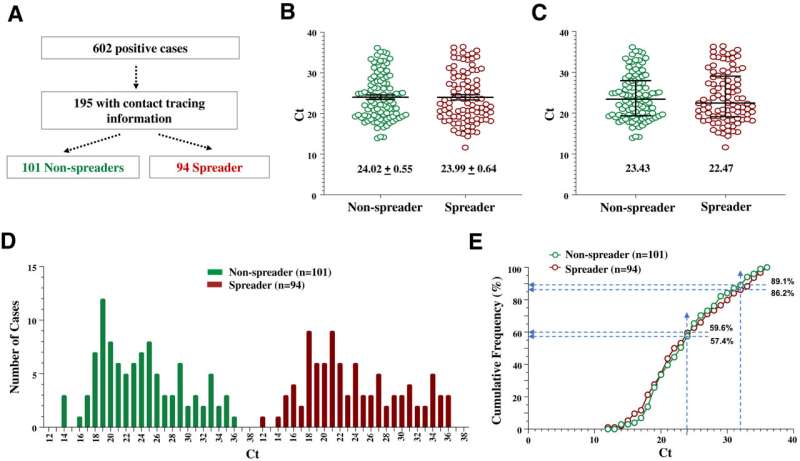The cycle threshold (Ct) values of the spreaders and the nonspreaders are largely overlapping. A: Separation of index cases into spreader and nonspreader groups. The n of the cases in each population is indicated. Scatter plots of Ct values expressed as means ± SEM (B) or median ± interquartile intervals (C). D: Histogram of the distribution of Ct values. E: Cumulative frequency of Ct values. Dashed lines indicate the cumulated percentage of each population at the designated Ct value (24 or 32). At the indicated Ct value of ≤ 24, there is a higher percentage of spreader cases than nonspreader cases, although the differences are small. Ct values of the indicated populations are compared. Mann-Whitney U test (P > 0.05). Credit: The Journal of Molecular Diagnostics
The transmission of SARS-CoV-2 virus is dependent on many factors. Although some in vitro studies indicate that the amount of virus isolated from infected individuals affects the successful rate of virus transmission, whether the viral load carried at the individual level can determine transmissibility was unknown. A study of college students who underwent regular testing and contact tracing after positive tests, found significant overlap in cycle thresholds (Ct) between spreaders and nonspreaders. This makes Ct values questionable in determining transmission rates. Even those with low viral loads can pass on the virus, researchers report in the Journal of Molecular Diagnostics.
"We wanted to find whether there was a scientifically sound way to quickly triage students with potential high-risk exposure to COVID-19 positive students for quarantine," explain co-lead authors Patrice Delafontaine, MD, Department of Medicine, and Xiao-Ming Yin, MD, Ph.D., Departments of Pathology and Laboratory Medicine, Tulane University School of Medicine, New Orleans, LA, U.S. "Some studies have found that the Ct value of the RT-PCR assay is a surrogate for infectivity, and cutoff Ct values have been proposed as a way to guide isolation practices. Through testing and contact tracing, we found that Ct value could not predict transmissibility. We should not overlook positive patients with low viral load, and all positive patients should be quarantined."
Tulane University maintained on-campus educational activities in the fall semester of 2020. A high-throughput SARS-CoV-2 surveillance testing program was established to support contact tracing, isolation, and quarantine efforts needed to restrict viral transmission throughout the campus. All students were tested twice a week. At the time of testing, students were asked about symptoms they may be experiencing. Contact tracers spoke to all positive case subjects to identify close contacts.
The study looked at 7,440 patients who were screened between September 1, 2020 and October 31, 2020. Six hundred and two positive cases were identified. From this group, 195 index cases were identified with one or more reported close contacts, who were then tested during their mandated 14-day quarantine period for evidence of transmission from the associated index cases. Of these index cases, 48.2% had at least one contact who became SARS-CoV-2 positive, whereas 51.8% of the index cases were nonspreaders with no contacts who subsequently tested positive. Mean Ct values of the spreaders and the nonspreaders were nearly identical.
The investigators then took a reverse approach, in which index cases were traced for 481 students undergoing quarantine due to known exposure to the disease. Eighteen percent of the students became positive during their quarantine. Index cases for the 481 quarantined students were considered spreaders if they were linked to one or more quarantine students with a positive test result, or nonspreaders if they were associated only with students with negative test results. The mean Ct values of the spreader and the nonspreader groups were similar.
Next the investigators identified and evaluated 375 positive COVID-19 cases to assess the relationship between symptom presentation and Ct values. Reported symptoms included lethargy, fever, headache, cough, runny nose, and gastrointestinal symptoms. The mean and median Ct values were significantly lower in symptomatic cases than in asymptomatic cases, indicating a higher viral load. These findings suggest that infections with a higher viral load may be more likely to lead to symptom development, or that symptomatic individuals tend to have higher viral loads or maintain their viral loads for a longer period of time. Ct levels may be useful at a population level, in association with symptomatic presentation, to indicate the likelihood of transmission. These values may thus have epidemiologic or surveillance importance.
"Taken together, these index cases suggest that Ct values alone do not predict transmission risk, and reporting of Ct values at the individual level, such as by setting a cutoff value of 32, would provide little diagnostic value for case management," note Dr. Delafontaine and Dr. Yin. "A sensitive and robust SARS-CoV-2 diagnostic testing method is needed to effectively control viral transmission by maximizing the ability to identify and quarantine even those with a low level of virus."
More information: Di Tian et al, Ct Values Do Not Predict Severe Acute Respiratory Syndrome Coronavirus 2 (SARS-CoV-2) Transmissibility in College Students, The Journal of Molecular Diagnostics (2021). DOI: 10.1016/j.jmoldx.2021.05.012
Journal information: Journal of Molecular Diagnostics
Provided by Elsevier
























